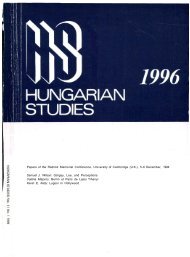The Canadian-American Review of Hungarian Studies - Vol. 4 ... - EPA
The Canadian-American Review of Hungarian Studies - Vol. 4 ... - EPA
The Canadian-American Review of Hungarian Studies - Vol. 4 ... - EPA
Create successful ePaper yourself
Turn your PDF publications into a flip-book with our unique Google optimized e-Paper software.
miklos, etc.) makes it impossible for the non-<strong>Hungarian</strong> reader to tracethe narrative on modern maps published outside Hungary. Similarly,the use <strong>of</strong> a correct but unfamiliar German geographical nomenclatureinstead <strong>of</strong> place names familiar from English historical writing (forexample, Hochstadt for Blenheim) fails to prompt instantaneous reactionin the lay reader's mind.Methodologically the text, which otherwise reads well, lapses intoweaknesses characteristic <strong>of</strong> dogmatic historiography. Hypothesis ispresented as historical fact, as on p. 15: "<strong>The</strong> ordinary Magyar [<strong>of</strong> theearly 10th century] had the choice <strong>of</strong> two alternatives: to join the armedbands or . . . to till the soil," etc. Historical fact incongruous with thejustification <strong>of</strong> a synthesis is omitted, as on p. 243: "Ferenc Nagy, whowas in Switzerland at the time . . . was summoned by the government toreturn home. . . Nagy refused and sent a letter <strong>of</strong> resignation instead."<strong>The</strong> non-captive reading public has the omitted facts available in FerencNagy's Struggle Behind the Iron Curtain, Macmillan: New York, 1948,pp. 405 426 and in the open diplomatic archives <strong>of</strong> the West. <strong>The</strong> bookends with a presentation <strong>of</strong> the establishment <strong>of</strong> the dictatorship <strong>of</strong> theproletariat in Hungary (p. 247) as a curtainraiser to the end <strong>of</strong> thedialectical process in that country and so perf orce <strong>of</strong> <strong>Hungarian</strong> history.<strong>The</strong> 1975 publication <strong>of</strong> this little book in Budapest roughly coincidedwith the signing in Helsinki <strong>of</strong> the Final Act <strong>of</strong> the Conference onSecurity and Cooperation in Europe. <strong>The</strong> fact that it is being freelydistributed in America by Imported Publications, Inc. <strong>of</strong> Chicagoshould be partial pro<strong>of</strong> <strong>of</strong> U.S. compliance with those "third-basket"desiderata <strong>of</strong> the Final Act which call for reciprocity in the free movement<strong>of</strong> ideas and in access to printed information. We hope that the<strong>Hungarian</strong> counterpart <strong>of</strong> the <strong>American</strong> Imported Publications, Inc.will soon be, if it isn't already, as free <strong>of</strong> government control in importingand distributing information originatinganywhere in the world as isthe Chicago firm which has placed Zoltan Halasz's book in our hands.Fort Thomas, KentuckyLeslie C. Tihany<strong>The</strong> Crises <strong>of</strong> France's East Central European Diplomacy, 1933-1938.By Anthony T. Komjathy. Boulder: East European Quarterly, 1977.Distributed by Columbia University Press. 277 pp.As a general rule scholars would agree that highly critical reviewsshould be kept as brief as possible, if indeed they should be written at all.
















